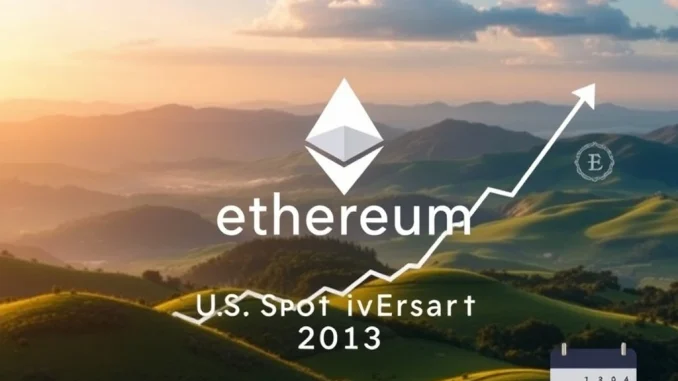
The world of digital assets is buzzing, and for good reason. Just when many thought the dust might settle, U.S. Ethereum ETFs have delivered a stunning performance, recording a combined net inflow of $192.3 million on July 15. This remarkable surge marks the eighth consecutive day of positive ETH inflows, signaling a robust and growing interest in the second-largest cryptocurrency.
What’s Driving the Momentum in Spot Ethereum ETFs?
The latest figures from Farside Investors paint a clear picture: the appetite for direct exposure to Ether through regulated financial products is escalating. The $192.3 million recorded on July 15 isn’t just a number; it represents a significant vote of confidence from investors seeking access to the spot Ethereum ETF market. This consistent streak of positive flows, now stretching to eight days, underscores a shift in how traditional finance views digital assets. Unlike futures-based ETFs, a spot Ethereum ETF holds actual ETH, providing a more direct investment vehicle that many institutional and retail investors prefer.
BlackRock ETHA Leads the Charge in ETH Inflows
Leading the pack in this impressive rally was BlackRock’s ETHA, which alone attracted a staggering $171.5 million in ETH inflows. This dominant performance by one of the world’s largest asset managers is particularly noteworthy. It signifies not only BlackRock’s strategic positioning in the crypto space but also the immense capital they can deploy into new asset classes. Following BlackRock, Fidelity’s FETH saw a respectable $12.2 million in inflows, while Grayscale’s mini ETH added $8.6 million. The presence of such prominent financial giants like BlackRock ETHA, Fidelity, and Grayscale in the top three contributors highlights a significant institutional embrace of Ethereum. Their participation lends credibility and liquidity to the nascent spot Ethereum ETF market, paving the way for broader adoption.
Understanding the Broader Crypto Investment Landscape
These substantial crypto investment figures aren’t isolated incidents; they are part of a larger narrative unfolding in the digital asset sector. Several factors are likely contributing to this renewed enthusiasm for Ethereum. Firstly, the increasing clarity on the regulatory front in the U.S. has provided a much-needed sense of security for institutional investors. The approval of spot Bitcoin ETFs earlier this year set a precedent, opening the floodgates for similar Ethereum-based products. Secondly, Ethereum’s fundamental strengths – its robust ecosystem, leading role in DeFi, NFTs, and smart contracts, and upcoming technological upgrades – continue to attract long-term holders. For investors, Ethereum ETFs offer several advantages: ease of access without the complexities of direct crypto custody, liquidity, and integration into traditional brokerage accounts. This accessibility is crucial for attracting a wider range of investors who might otherwise be hesitant to venture into direct crypto purchases.
The Road Ahead: What’s Next for the Spot Ethereum ETF Market?
While the recent ETH inflows are overwhelmingly positive, it’s important to consider the road ahead. The cryptocurrency market remains inherently volatile, and investors should be prepared for potential price fluctuations. Regulatory landscapes can also shift, impacting the flow of funds. However, the consistent demand seen for the spot Ethereum ETF suggests a growing maturity in the market. The successful launch and continued positive performance of these ETFs could pave the way for even more sophisticated financial products linked to Ethereum and other digital assets. This institutional validation is critical for the long-term health and growth of the entire crypto ecosystem. As more traditional investors gain comfortable, regulated access to digital assets, we could see an acceleration of mainstream adoption and innovation within the blockchain space.
The recent surge in U.S. spot Ethereum ETF inflows marks a pivotal moment for the crypto industry. With major players like BlackRock leading the charge, the institutional embrace of Ethereum is becoming undeniable. This consistent positive momentum not only validates Ethereum’s position as a foundational digital asset but also signals a growing comfort among traditional investors with regulated crypto investment vehicles. As the market continues to evolve, the performance of these ETFs will serve as a key indicator of broader investor sentiment and the ongoing integration of digital assets into the global financial landscape. The future of crypto investment looks brighter than ever.



